Two words: Joan Rivers.
Howard Hawks directs this 1932 classic starring Paul Muni as one of cinema’s most violent and psychologically disturbed gangsters, Tony “Scarface” Camonte. The film was actually made in 1930, but due to its controversial themes and violence Hawks had to fight the censors to have it released. After many concessions on the part of Hawks, most notably the subtitle, United Artist released it. It did poorly at the box office and a number of states banned it. Hawks withdrew it from circulation and for nearly fifty years it was virtually nonexistent. Written by legendary screenplay writer Ben Hecht in eleven days, the story chronicles the rise and fall of a Prohibition Era Chicago crime boss. Interestingly, Brian De Palma dedicated his Scarface (1983) to Hecht.
After an introductory warning about the insidiousness of organized crime, the film opens with the murder of Chicago crime boss Big Louis Costillo (Harry J. Vejar) in a telephone phone. Who puts a cap in him, you ask? Why, none other than our Scarface (and Louis’ bodyguard). Hawks adroitly chose to introduce  the audience to Muni’s character through the use of shadow, as well as whistling a song from Lucia di Lammermoor (a 19th century version of feuding families). Take heed, whenever you hear Scarface whistling someone is about to die. In addition, as Scarface shoots Louis an X or a cross appears; this is also a signal used throughout the film that an unnatural death is imminent.
the audience to Muni’s character through the use of shadow, as well as whistling a song from Lucia di Lammermoor (a 19th century version of feuding families). Take heed, whenever you hear Scarface whistling someone is about to die. In addition, as Scarface shoots Louis an X or a cross appears; this is also a signal used throughout the film that an unnatural death is imminent.
The next day we find Scarface and his coin-flipping associate Guino Rinaldo (George Raft, and yes, this is where his coin flipping trademark began) in a barber shop where they are arrested. We are finally introduced to Tony Camonte’s face, which has an X-shaped scar on his left cheek, hence the nickname “Scarface”. At the police station we learn that Scarface has a long rap sheet and a bad reputation. The police believe Scarface was carrying out the orders 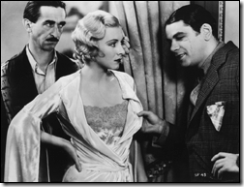 of his new boss, Johnny Lovo (Osgood Perkins—yes Anthony’s father), but he won’t talk and they have to release him. When he goes to visit Lovo he meets his moll, Poppy (Karen Morley). She is a total bitch to him and has the audacity to insult his scared face.
of his new boss, Johnny Lovo (Osgood Perkins—yes Anthony’s father), but he won’t talk and they have to release him. When he goes to visit Lovo he meets his moll, Poppy (Karen Morley). She is a total bitch to him and has the audacity to insult his scared face.
Later we meet Scarface’s immigrant family, his sister Cesca (Ann Dvorak) and mother (Inez Palange). Scarface had a need to control Cesca’s every move and is strangely jealous of any man who looks at her once. Hawkss hints at the idea that Scarface has incestuous feelings for his sister. If this relationship wasn’t sick enough, his mother calls him no good to his face and to anyone else who will listen. Problems soon present themselves when Cesca shows an interest in Guino.
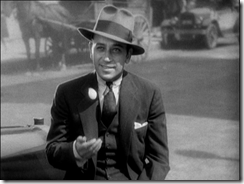 Meanwhile, Tony becomes both enforcer and collector for Lovo’s bootlegging operation. Hawks uses montage to show how Scarface and Guino take control of South Side Chicago. One of the more memorable murders takes place in a hospital, where Scarface and his goons carry flower arrangements throughout the hospital looking for their victim. As Scarface becomes more powerful, Lovo fears he’s losing control and that his lackey is about to push into their rival O’Hara’s North Side territory. His fears are realized when Guino kills O’Hara in a flower shop. In addition, now that Scarface has money and power, Polly starts to pay him attention.
Meanwhile, Tony becomes both enforcer and collector for Lovo’s bootlegging operation. Hawks uses montage to show how Scarface and Guino take control of South Side Chicago. One of the more memorable murders takes place in a hospital, where Scarface and his goons carry flower arrangements throughout the hospital looking for their victim. As Scarface becomes more powerful, Lovo fears he’s losing control and that his lackey is about to push into their rival O’Hara’s North Side territory. His fears are realized when Guino kills O’Hara in a flower shop. In addition, now that Scarface has money and power, Polly starts to pay him attention.
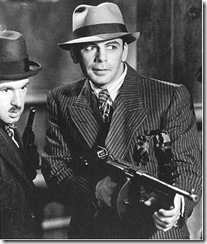 Perhaps he shouldn’t have killed O’Hara, because his successor, Gaffney (Boris Karloff), decides to declare war on Scarface with the use of tommy guns. Gaffney tries to ambush Scarface by setting up a fake funeral procession outside a restaurant he’s eating at. This attempt is a failure, but it impresses Scarface and he decides he needs tommy guns, too. Thus, a gang war erupts and countless machine guns mow down gangsters. There are too many X’s to recount, but my favorites are of the man lying dead outside a mortuary and the St. Valentine’s Massacre where seven X’s appear as ceiling beams above Gaffney’s gang. Oddly enough, Gaffney wasn’t present at the massacre—Hawks and Hecht had something more special planned for him. While bowling (really?), Gaffney scores a strike and an X is marked on his score sheet. Usually this would be cause for celebration, but instead he is mowed down by machine guns as he throws his next ball—coincidentally another strike.
Perhaps he shouldn’t have killed O’Hara, because his successor, Gaffney (Boris Karloff), decides to declare war on Scarface with the use of tommy guns. Gaffney tries to ambush Scarface by setting up a fake funeral procession outside a restaurant he’s eating at. This attempt is a failure, but it impresses Scarface and he decides he needs tommy guns, too. Thus, a gang war erupts and countless machine guns mow down gangsters. There are too many X’s to recount, but my favorites are of the man lying dead outside a mortuary and the St. Valentine’s Massacre where seven X’s appear as ceiling beams above Gaffney’s gang. Oddly enough, Gaffney wasn’t present at the massacre—Hawks and Hecht had something more special planned for him. While bowling (really?), Gaffney scores a strike and an X is marked on his score sheet. Usually this would be cause for celebration, but instead he is mowed down by machine guns as he throws his next ball—coincidentally another strike.
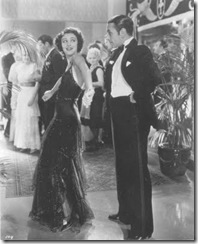 With Gaffney out of the way, Scarface is on a high and has no problem being disrespectful to Lovo. Seeing Polly’s interest in Scarface, Lovo decides he needs to take him out. Too bad Cesca has decided to seduce Guino, who is trying to avoid her because she’s the boss’ sister. When he rebuffs her, she decides to dance with another man. When Scarface sees this, he punches the man and drags Cesca (who happens to be wearing an X-backed dress) home without his bodyguards. The scene at home is dark and violent. He slaps Cesca around and rips her dress.
With Gaffney out of the way, Scarface is on a high and has no problem being disrespectful to Lovo. Seeing Polly’s interest in Scarface, Lovo decides he needs to take him out. Too bad Cesca has decided to seduce Guino, who is trying to avoid her because she’s the boss’ sister. When he rebuffs her, she decides to dance with another man. When Scarface sees this, he punches the man and drags Cesca (who happens to be wearing an X-backed dress) home without his bodyguards. The scene at home is dark and violent. He slaps Cesca around and rips her dress. 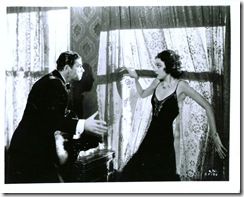 When Scarface leaves the house bullets fly overhead, barely missing him as he escapes in his car. Pursued by would-be assassins in a high speed chase, he’s run off the road and crashes. Scarface survives and he and Guino confront Lovo, whom they suspect put a hit out on Scarface. Whistling his Lucia di Lammermoor again, Scarface orders Guino to kill Lovo.
When Scarface leaves the house bullets fly overhead, barely missing him as he escapes in his car. Pursued by would-be assassins in a high speed chase, he’s run off the road and crashes. Scarface survives and he and Guino confront Lovo, whom they suspect put a hit out on Scarface. Whistling his Lucia di Lammermoor again, Scarface orders Guino to kill Lovo.
Now that Lovo’s no longer the boss (or breathing), Poppy is ordered by Scarface to go into hiding with him. With her brother out of the picture, Cesca steps up her seduction plan for Guino and they become involved. When Scarface returns to Chicago he learns from his mother that Cesca is living with a man and he suspects Guino is the man. When Scarface goes to their apartment, whistling 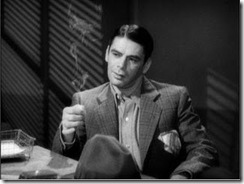 his “special” tune he finds apartment X and his right-hand man. Off-screen shots ring out and Guino doesn’t catch his last flipped coin. A grief-stricken Cesca informs her brother that he just killed her husband. Oops. Scarface is devastated and takes refuge in his fortress of an apartment. With the police stationed outside and preparing to storm the building, Cesca goes to her brother’s to kill him. She can’t pull the trigger and actually comforts him and attempts to help him escape. They unite in violence and shoot at the police. Cesca takes a stray bullet and dies. As tear gas is thrown in the window, Scarface is forced out of the apartment. At first he begs the police not to shoot him, but then decides to make a break for it. Police gunfire fills his body with lead. When his body hits the ground it lands in a gutter.
his “special” tune he finds apartment X and his right-hand man. Off-screen shots ring out and Guino doesn’t catch his last flipped coin. A grief-stricken Cesca informs her brother that he just killed her husband. Oops. Scarface is devastated and takes refuge in his fortress of an apartment. With the police stationed outside and preparing to storm the building, Cesca goes to her brother’s to kill him. She can’t pull the trigger and actually comforts him and attempts to help him escape. They unite in violence and shoot at the police. Cesca takes a stray bullet and dies. As tear gas is thrown in the window, Scarface is forced out of the apartment. At first he begs the police not to shoot him, but then decides to make a break for it. Police gunfire fills his body with lead. When his body hits the ground it lands in a gutter.
In a tacked on ending that Hawks refused to direct, we learn Scarface has survived his injuries and is sentenced to death by hanging. These last scenes are shot from a distance and you never see his face. This would be because Muni didn’t shoot these scenes, instead a silhouetted stand-in was used. The final scene has a guard placing a black hood over Scarface’s head and the signal for the execution. This was a very stark ending—one of those fade to black endings that basically say “enough said”.
The foreshadowing element of the X symbol and Scarface’s whistling of Lucia di Lammermoor is very effective. Hawks and cinematographers Lee Garmes and L. William O’Connell are extremely clever in their usage of this device. In addition, the dark, shadowy world that they create is especially apt for the subject matter which they are depicting.
The story itself is entertaining, but this is not my favorite gangster film. Muni is effective in the role, but at times I felt he was trying too hard. The way he speaks in the stereotypical Italian immigrant accent is a tad grating at times. My favorite part of the film, other than the symbolic X’s, is George Raft as Guino. He just looks very comfortable in this role.
Not the best gangster film, but still an entertaining depiction of organized crime during Prohibition.

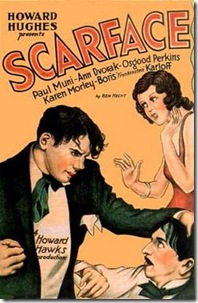
Kim , Hawks, Wellmen, and Leroy sure set the pattern for every gangster film that followed. I think Muni is the most frighting between Robinson, and Cagney. I think Hawks more than hints at incest between Cesca, and Scareface. Very Good Post.
ReplyDelete